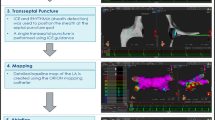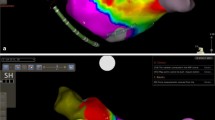Abstract
Fluoroscopy is the principal imaging method for catheter ablation (CA) of atrial fibrillation (AF). However, radiation exposure carries potential health risk to patients and operators alike. Our aim was to study safety and efficacy of zero-fluoroscopy CA of paroxysmal AF with a combined use of electroanatomic mapping system (EAM) and intracardiac echocardiography (ICE). In addition, impact of ICE/EAM automatic integration system and contact force (CF) sensing technology on procedural times were assessed. We included 144 consecutive patients (69% males, age 60 ± 10 years, BMI 29 ± 4,6) referred for CA of symptomatic paroxysmal AF. All procedures were performed only with EAM system and ICE. No fluoroscopy was used. The acute procedural success of complete pulmonary vein isolation was achieved in all patients (100%) and adverse events were detected in eight patients (5.6%). In 53 (37%) patients the use of ICE/EAM automatic integration system shortened procedural times compared to those performed without it (148 ± 35 vs. 187 ± 44 min, p < 0.05). Similarly, 89 (60%) procedures where CF sensing catheter was used were shorter compared to those performed without it (163 ± 41 vs. 188 ± 46 min, p < 0.05). Zero-fluoroscopy approach for treatment of paroxysmal AF seems feasible, safe, and acutely effective. Additional reduction of procedural times could be achieved with the use of ICE/EAM automatic integration system and CF sensing technology.



Similar content being viewed by others
References
Roguin A, Goldstein J, Bar O, Goldstein JA (2013) Brain and neck tumors among physicians performing interventional procedures. Am J Cardiol 111(9):1368–1372
Jacob S, Boveda S, Bar O, Brézin A, Maccia C, Laurier D, Bernier MO (2013) Interventional cardiologists and risk of radiation-induced cataract: results of a French multicenter observational study. Int J Cardiol 167(5):1843–1847
Ector J, Dragusin O, Adriaenssens B, Huybrechts W, Willems R, Ector H, Heidbüchel H (2007) Obesity is a major determinant of radiation dose in patients undergoing pulmonary vein isolation for atrial fibrillation. J Am Coll Cardiol 50(3):234–242
Heidbuchel H, Wittkampf FHM, Vano E, Ernst S, Schilling R, Picano E, Mont L (2014) Practical ways to reduce radiation dose for patients and staff during device implantations and electrophysiological procedures. Europace 16:946–964
Reddy VY, Morales G, Ahmed H, Neuzil P, Dukkipati S, Kim S, Clemens J, D’Avila A (2010) Catheter ablation of atrial fibrillation without the use of fluoroscopy. Heart Rhythm 7(11):1644–1653
Bulava A, Hanis J, Eisenberger M (2015) Catheter ablation of atrial fibrillation using zero-fluoroscopy technique: a randomized trial. Pacing Clin Electrophysiol 38(7):797–806
Perisinakis K, Damilakis J, Theocharopoulos N, Manios E, Vardas P, Gourtsoyiannis N (2001) Accurate assessment of patient effective radiation dose and associated detriment risk from radiofrequency catheter ablation procedures. Circulation 104:58–62
Lavie CJ, Pandey A, Lau DH, Alpert MA, Sanders P (2017) Obesity and atrial fibrillation prevalence, pathogenesis, and prognosis: effects of weight loss and exercise. J Am Coll Cardiol 70(16):2022–2035
Crowhurst J, Whitby M (2018) Lowering fluoroscopy pulse rates to reduce radiation dose during cardiac procedures. J Med Radiat Sci. 65(4):247–249
Crowhurst JA, Whitby M, Savage M, Murdoch D, Robinson B, Shaw E, Gaikwad N, Saireddy R, Hay K, Walters DL (2019) Factors contributing to radiation dose for patients and operators during diagnostic cardiac angiography. J Med Radiat Sci. 66(1):20–29
Haegeli LM, Stutz L, Mohsen M, Wolber T, Brunckhorst C, On CJ, Duru F (2018) Feasibility of zero or near zero fluoroscopy during catheter ablation procedures. Cardiol J. https://doi.org/10.5603/cj.a2018.0029
Raju H, Whitaker J, Taylor C, Wright M (2016) Electroanatomic mapping and transoesophageal echocardiography for near zero fluoroscopy during complex left atrial ablation. Heart Lung Circ. 25(7):652–660
Kühne M, Knecht S, Mühl A, Reichlin T, Pavlović N, Kessel-Schaefer A, Kaufmann BA, Schaer B, Sticherling C, Osswald S (2016) Fluoroscopy-free pulmonary vein isolation in patients with atrial fibrillation and a patent foramen ovale using solely an electroanatomic mapping system. PLoS ONE 11(1):e0148059
Liu X, Palmer J (2018) Outcomes of 200 consecutive, fluoroless atrial fibrillation ablations using a new technique. Pacing Clin Electrophysiol 41(11):1404–1411
Razminia M, Willoughby MC, Demo H, Keshmiri H, Wang T, D’Silva OJ, Zheutlin TA, Jibawi H, Okhumale P, Kehoe RF (2017) Fluoroless catheter ablation of cardiac arrhythmias: a 5-year experience. Pacing Clin Electrophysiol 40(4):425–433
Razminia M, Manankil MF, Eryazici PL, Arrieta-Garcia C, Wang T, D’Silva OJ, Lopez CS, Crystal GJ, Khan S, Stancu MM, Turner M, Anthony J, Zheutlin TA, Kehoe RF (2012) Nonfluoroscopic catheter ablation of cardiac arrhythmias in adults: feasibility, safety, and efficacy. J Cardiovasc Electrophysiol 23(10):1078–1086
Baran J, Zaborska B, Piotrowski R, Sikora-Frąc M, Pilichowska-Paszkiet E, Kułakowski P (2017) Intracardiac echocardiography for verification for left atrial appendage thrombus presence detected by transesophageal echocardiography: the ActionICE II study. Clin Cardiol 40(7):450–454
Nguyen DT, Zipse M, Borne RT, Zheng L, Tzou WS, Sauer WH (2018) Use of tissue electric and ultrasound characteristics to predict and prevent steam-generated cavitation during high-power radiofrequency ablation. JACC Clin Electrophysiol. 4(4):491–500
Filgueiras-Rama D, de Torres-Alba F, Castrejón-Castrejón S, Estrada A, Figueroa J, Salvador-Montañés Ó, López T, Moreno-Yanguela M, López Sendón JL, Merino JL (2015) Utility of intracardiac echocardiography for catheter ablation of complex cardiac arrhythmias in a medium-volume training center. Echocardiography. 32(4):660–670
Ruisi CP, Brysiewicz N, Asnes JD, Sugeng L, Marieb M, Clancy J, Akar JG (2013) Use of intracardiac echocardiography during atrial fibrillation ablation. Pacing Clin Electrophysiol 36(6):781–788
Clark J, Bockoven JR, Lane J, Patel CR, Smith G (2008) Use of three-dimensional catheter guidance and trans-esophageal echocardiography to eliminate fluoroscopy in catheter ablation of left-sided accessory pathways. Pacing Clin Electrophysiol 31(3):283–289
Álvarez M, Tercedor L, Herrera N, Muñoz L, Galdeano RS, Valverde F, Peñas R, Melgares R (2011) Cavotricuspid isthmus catheter ablation without the use of fluoroscopy as a first-line treatment. J Cardiovasc Electrophysiol 22(6):656–662
Fernández-Gómez JM, Moriña-Vázquez P, Morales Edel R, Venegas-Gamero J, Barba-Pichardo R, Carranza MH (2014) Exclusion of fluoroscopy use in catheter ablation procedures: six years of experience at a single center. J Cardiovasc Electrophysiol 25(6):638–644
Stec S, Śledź J, Mazij M, Raś M, Ludwik B, Chrabąszcz M, Śledź A, Banasik M, Bzymek M, Młynarczyk K, Deutsch K, Labus M, Śpikowski J, Szydłowski L (2014) Feasibility of implementation of a “simplified, no-X-ray, no-lead apron, two-catheter approach” for ablation of supraventricular arrhythmias in children and adults. J Cardiovasc Electrophysiol 25(8):866–874
Sadek MM, Ramirez FD, Nery PB, Golian M, Redpath CJ, Nair GM, Birnie DH (2019) Completely nonfluoroscopic catheter ablation of left atrial arrhythmias and ventricular tachycardia. J Cardiovasc Electrophysiol 30(1):78–88
Phlips T, Taghji P, El Haddad M, Wolf M, Knecht S, Vandekerckhove Y, Tavernier R, Duytschaever M (2018) Improving procedural and one-year outcome after contact force-guided pulmonary vein isolation: the role of interlesion distance, ablation index, and contact force variability in the ‘CLOSE’-protocol. Europace 20(FI_3):f419–f427
Kuck KH, Brugada J, Fürnkranz A, Metzner A, Ouyang F, Chun KR, Elvan A, Arentz T, Bestehorn K, Pocock SJ, Albenque JP, Tondo C, FIRE AND ICE Investigators (2016) Cryoballoon or radiofrequency ablation for paroxysmal atrial fibrillation. N Engl J Med. 374(23):2235–2245
Mörtsell D, Arbelo E, Dagres N, Brugada J, Laroche C, Trines SA, Malmborg H, Höglund N, Tavazzi L, Pokushalov E, Stabile G, Blomström-Lundqvist C, ESC-EHRA Atrial Fibrillation Ablation Long-Term Registry investigators (2019) Cryoballoon vs. radiofrequency ablation for atrial fibrillation: a study of outcome and safety based on the ESC-EHRA atrial fibrillation ablation long-term registry and the Swedish catheter ablation registry. Europace 21(4):581–589
Squara F, Zhao A, Marijon E, Latcu DG, Providencia R, Di Giovanni G, Jauvert G, Jourda F, Chierchia GB, De Asmundis C, Ciconte G, Alonso C, Grimard C, Boveda S, Cauchemez B, Saoudi N, Brugada P, Albenque JP, Thomas O (2015) Comparison between radiofrequency with contact force-sensing and second-generation cryoballoon for paroxysmal atrial fibrillation catheter ablation: a multicentre European evaluation. Europace. 17(5):718–724
Bollmann A, Ueberham L, Schuler E, Wiedemann M, Reithmann C, Sause A, Tebbenjohanns J, Schade A, Shin DI, Staudt A, Zacharzowsky U, Ulbrich M, Wetzel U, Neuser H, Bode K, Kuhlen R, Hindricks G (2018) Cardiac tamponade in catheter ablation of atrial fibrillation: german-wide analysis of 21 141 procedures in the Helios atrial fibrillation ablation registry (SAFER). Europace. 20(12):1944–1951
Author information
Authors and Affiliations
Corresponding author
Ethics declarations
Conflict of interest
Matevž Jan and Bor Antolič have received honoraria from Biosense Webster. These honoraria were unrelated to the present study.
Financial support/funding
None.
Ethical approval
The study complies with the Declaration of Helsinki. The study protocol was approved by The National Medical Ethics Committee.
Informed consent
All patients gave written informed consent before entering the study.
Additional information
Publisher's Note
Springer Nature remains neutral with regard to jurisdictional claims in published maps and institutional affiliations.
Rights and permissions
About this article
Cite this article
Jan, M., Žižek, D., Kuhelj, D. et al. Combined use of electro-anatomic mapping system and intracardiac echocardiography to achieve zero-fluoroscopy catheter ablation for treatment of paroxysmal atrial fibrillation: a single centre experience. Int J Cardiovasc Imaging 36, 415–422 (2020). https://doi.org/10.1007/s10554-019-01727-1
Received:
Accepted:
Published:
Issue Date:
DOI: https://doi.org/10.1007/s10554-019-01727-1




